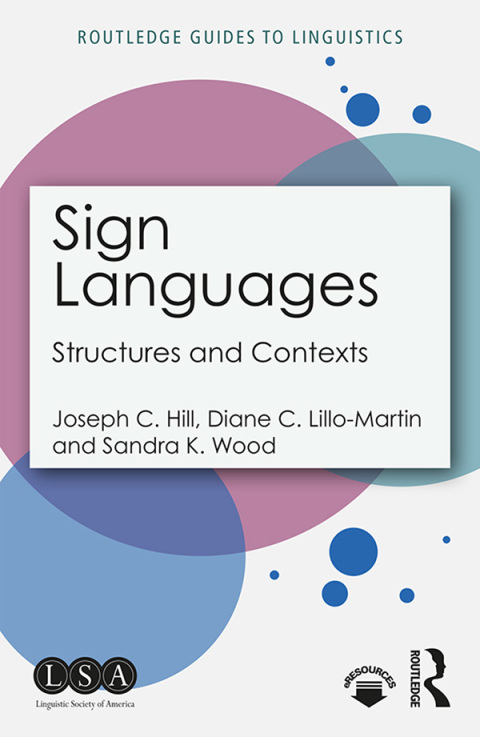Description
Efnisyfirlit
- Cover
- Half Title
- Series Page
- Title Page
- Copyright Page
- Table of Contents
- List of figures
- List of tables
- Acknowledgments
- 1 Introduction
- 1.1 Sign languages and their users
- 1.2 Sign languages and American Sign Language
- 1.3 Key linguistic concepts
- 1.4 Using this book
- 2 Phonology
- 2.1 What is phonology?
- 2.2 Signs have parts
- 2.3 Signs are constrained
- 2.4 Linearity and simultaneity
- 2.5 Sign language prosody
- 2.6 Are there syllables in sign languages?
- 2.7 Conclusion
- 3 Morphology
- 3.1 What is morphology?
- 3.2 Word formation
- 3.2.1 Iconicity
- 3.2.2 Compounding
- 3.2.3 Fingerspelling and initialization
- 3.3 Derivation
- 3.3.1 Noun–verb pairs
- 3.3.2 Other types of derivation
- 3.4 Inflection
- 3.4.1 Verbal morphology
- 3.4.2 Pluralization
- 3.5 Classifiers
- 3.6 Conclusion
- 4 Syntax
- 4.1 Introduction: what is syntax?
- 4.1.1 Overview of the chapter
- 4.2 Word order in ASL
- 4.3 Syntactic structures with brow raise
- 4.3.1 Yes/no interrogatives
- 4.3.2 Conditionals
- 4.3.3 Topicalization
- 4.4 Wh-questions
- 4.4.1 Marking the wh-question
- 4.4.2 The four WHATs
- 4.4.3 Position of the wh-word
- 4.4.4 Wh-doubling and multiple wh-questions
- 4.5 Negation
- 4.5.1 Nonmanuals for negation
- 4.5.2 Lexical signs for negation
- 4.5.3 Doubling and negative concord
- 4.6 Conclusion
- 5 Children with input from birth
- 5.1 Deaf children of Deaf, signing parents
- 5.1.1 The first steps
- 5.1.2 Lexical development
- 5.1.3 Phonological development
- 5.1.4 Development of morphology and syntax
- 5.1.5 Iconicity and sign language development
- 5.2 Bimodal bilingualism
- 5.2.1 Simultaneous acquisition of a sign language and a spoken language – Kodas
- 5.2.2 Simultaneous acquisition of a sign language and a spoken language: DDCI
- 5.3 Effects of non-native input
- 5.4 Conclusion
- 6 Contexts of later language development
- 6.1 The critical period hypothesis
- 6.2 Children receiving late input in a sign language
- 6.3 Adults who had received late input in a sign language
- 6.4 Adults learning a sign language as L2
- 6.5 Signers learning the written form of a spoken language
- 6.6 Conclusion
- 7 Homesign systems
- 7.1 Introduction
- 7.2 What are homesigns?
- 7.2.1 Components of a homesign system
- 7.2.2 Cross-cultural comparisons of homesigners
- 7.3 Adult homesigners
- 7.4 Homesigners’ acquisition of a conventional signed language
- 7.5 Conclusion
- 8 Variation
- 8.1 Sociocultural components in linguistic theories
- 8.2 Conditions affecting language use and variation
- 8.2.1 Factors in the formation and maintenance of sign languages
- 8.2.2 Families of sign languages in historical, linguistic, and social contexts
- 8.3 Variation within sign languages
- 8.3.1 Geographical factors in variation
- 8.3.2 Social factors in variation
- 8.3.3 Factors unique to sign languages
- 8.4 Impracticality of maintaining a universal sign language
- 8.5 Conclusion
- 9 Language attitudes
- 9.1 Defining attitudes
- 9.2 Attitudes toward language, culture, and identity
- 9.2.1 The case of racism and language in the United States
- 9.2.2 The case of cultural identity and language in the American Deaf community
- 9.3 Notion of standard and prestige
- 9.3.1 Linguistic and social differences between varieties
- 9.3.2 Overt prestige
- 9.3.3 Covert prestige
- 9.4 Language attitudes and choices in a diglossic context
- 9.5 Conclusion
- 10 Language policy and planning
- 10.1 Written and unwritten rules for language use
- 10.2 Language practices
- 10.2.1 Language practices in sign language
- 10.3 Language ideology
- 10.3.1 Language ideology about sign languages
- 10.4 Language management
- 10.4.1 Status planning
- 10.4.2 Corpus planning
- 10.4.3 Acquisition planning
- 10.5 Conclusion
- 11 Conclusion
- Index






Reviews
There are no reviews yet.